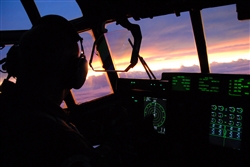Hunters Track Ike as Storm Moves Toward TexasBy Air Force Tech. Sgt. James B. Pritchett
Special to American Forces Press Service
|
|
KEESLER AIR FORCE BASE, Miss., Sept. 12, 2008 – Barreling toward the Texas coast, Hurricane Ike is gaining strength as millions of residents in the storm’s forecast path evacuate in expectation of an overnight landfall tonight.

Lt. Col. Mark Carter looks at the sunset after flying nine hours on a Hurricane Ike mission on board a WC-130J Hercules, Sept. 10, 2008, over the Gulf of Mexico. The Air Force Reserve Hurricane Hunters of the 403rd Wing at Keesler Air Force Base, Miss, fly 24-hours-a-day, collecting data inside the heart of Hurricane Ike. The data collected by the Hurricane Hunters improve the National Hurricane Center forecast by 30 percent. Colonel Carter is a pilot with the 403rd Wing. U.S. Air Force photo by Maj. Chad E. Gibson
(Click photo for screen-resolution image);high-resolution image available. |
|
As Ike entered the Gulf of Mexico after battering Cuba this week, a WC-130J Hurricane Hunter crew based here flew into the storm, pinpointing the center and sending flight-level and surface-level readings back to the National Hurricane Center via satellite.
Citizen-airmen of the 53rd Weather Reconnaissance Squadron, charged with flying directly into the eye of nature's most powerful storms, continue around-the-clock flights into Ike giving forecasters at the NHC the best possible data.
Hurricane Ike, now a Category 2 on the Safir-Simpson Scale, is expected to intensify before making landfall early tomorrow. The storm already has killed 80 people in the Caribbean and took a significant toll on parts of Cuba, especially areas previously affected by Hurricane Gustav.
As of 8 a.m. EDT today, Ike’s center was about 365 miles east of Corpus Christi, Texas, and about 230 miles southeast of Galveston, Texas, according to a National Hurricane Center advisory.
Maximum sustained winds were at 105 mph, but the storm is expected to strengthen before it moves ashore, and is forecast to be a major hurricane by then, the advisory said. The storm is moving west-northwest at 13 mph. A turn to the northwest is expected today, forecasters said, with a turn toward the north expected tomorrow.
Residents in the projected path and near those regions are urged to pay close attention to government and news sources in their areas for critical watches and warnings.
(Air Force Tech. Sgt. James B. Pritchett serves in the 403rd Wing Public Affairs Office.)
|
|